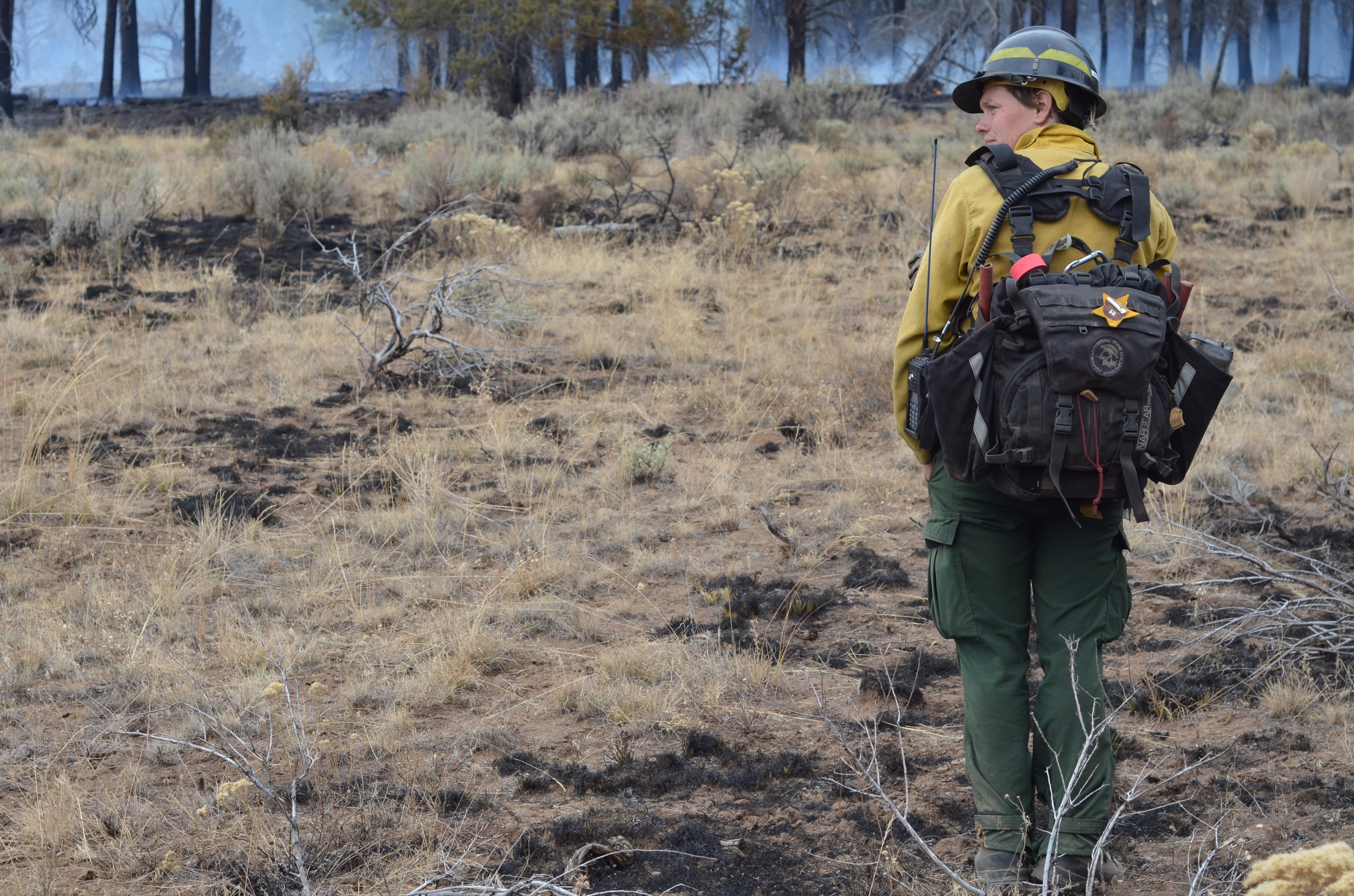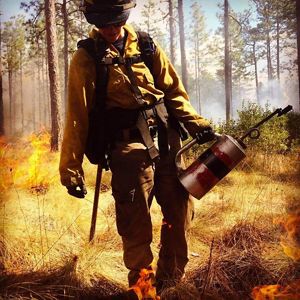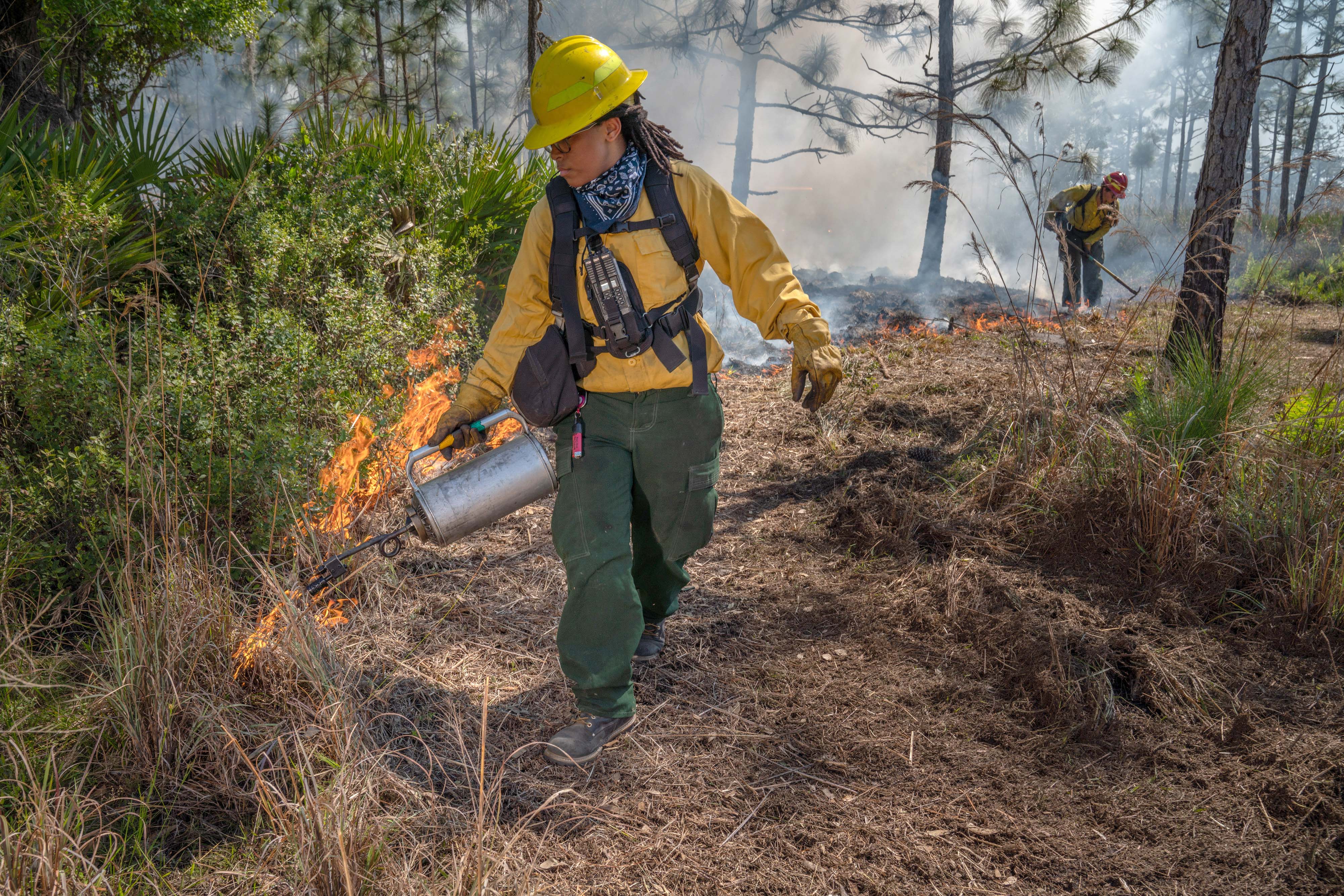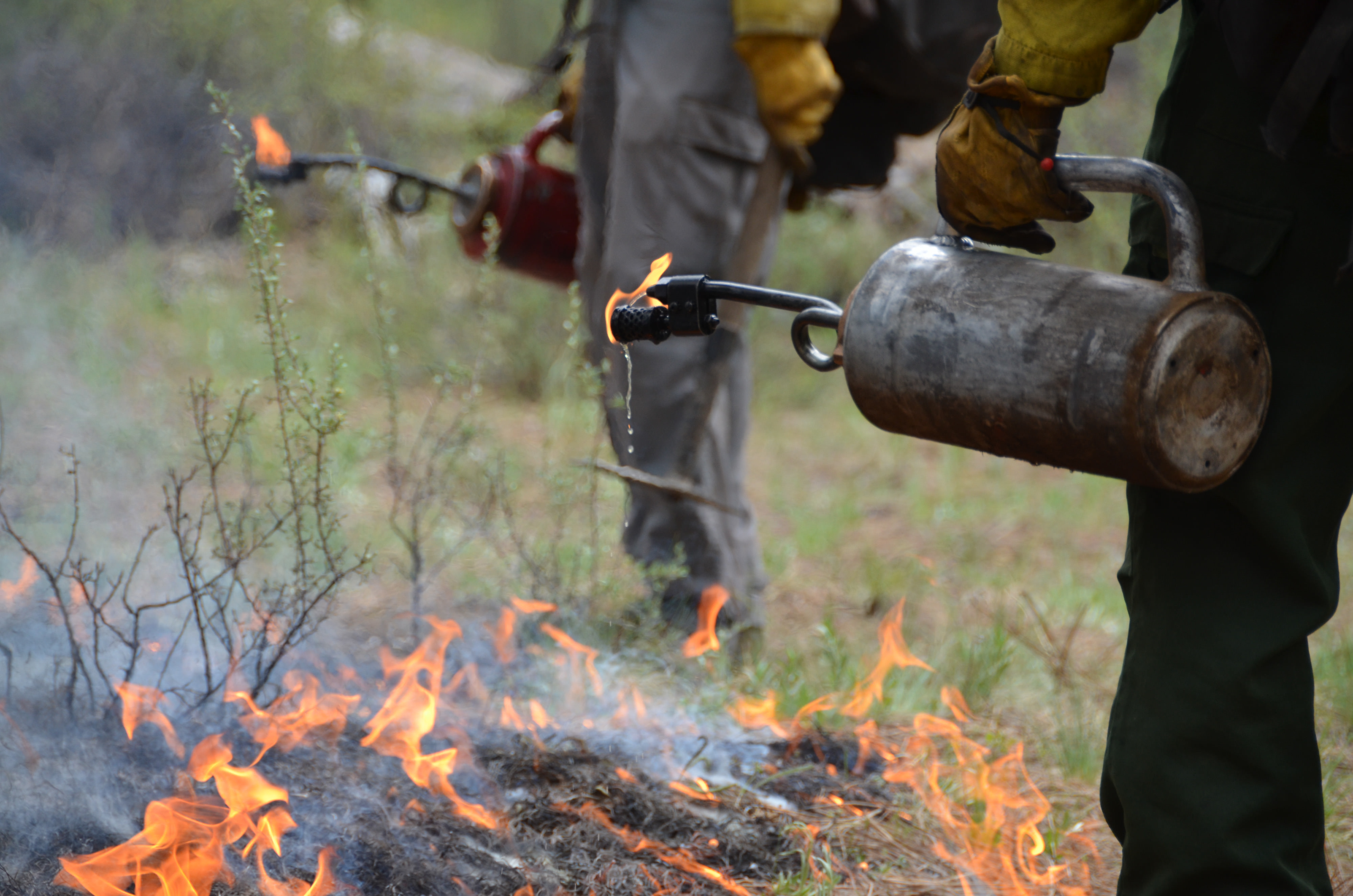Life On The Fire Line
Burn Boss Katie Sauerbrey talks about their passion for prescribed fire and the importance of diverse perspectives in fire management.
Fire is a natural and essential element in the dry forests of eastern and southern Oregon, and has been used since time immemorial by Indigenous Peoples to steward the land. Over the past century, however, naturally occurring wildfires have been put out as quickly as possible, which has allowed overgrowth to accumulate on the forest floor. This fuel, paired with hotter, drier conditions caused by climate change, is causing more intense and destructive wildfires.
To bring our forests back into balance, low-intensity fire must be reintroduced to Oregon’s dry forests. We sat down with Katie Sauerbrey, Fire Program Director and Burn Boss for The Nature Conservancy in Oregon, to talk about their passion for the work and the importance of including diverse perspectives.
TNC: For those who aren’t familiar with this sort of work, could you explain your role with The Nature Conservancy?
Katie Sauerbrey: Prescribed fire is an important part of caring for TNC preserves such as Sycan Marsh, a 30,000-acre nature preserve in south-central Oregon. I plan and implement prescribed fire as part of a stewardship effort that includes ecological thinning, invasive species management and projects that benefit wildlife such as bull trout. I coordinate with federal and state agencies, work with researchers from around the world and partner with Indigenous Peoples to create a shared future of healthy lands, waters and communities for all. Sycan Marsh Preserve is an historic site for The Klamath Tribes, who have a long history and culture tied to fire in the region.
I also oversee TNC’s statewide fire program in Oregon as the Acting Fire Manager and prescribed fire burn boss. In this role, I lead a team of fire practitioners that conduct safe and strategic controlled burns to improve the health of the ecosystem of Oregon’s dry forests and reduce the risk of intense and destructive summer wildfires. Being a burn boss and improving the health and resiliency of the forests that I love is an incredibly rewarding job.
TNC: In addition to your work with TNC, you have also helped support efforts to fight wildfire including those that burned more than one million acres in Oregon in 2020. Could you tell us about that experience and how it continues to shape your perspective?
KS: During fire season, I support wildland firefighting efforts in the dry forests of eastern and Southern Oregon, where summer fires are common. In 2020, however, we experienced tragic wildfires in our wet forests west of the Cascades. These forests historically burn much less frequently and are likely to burn more intensely when they do. Fires here occur when drought, dry conditions and extreme weather align—and that’s exactly what happened that year. I spent a month assigned to the Lionshead Fire, which started near Mount Jefferson and ultimately spread to over 200,000 acres. It was unlike anything I had ever seen in my career. The fires of that summer spread from the Cascade crest across our western Oregon forests, devastating many communities.
There was so much fire on the landscape across Oregon, and all of the firefighting resources and personnel were assigned. Some of the folks I was with on that fire didn’t even know if their own homes were safe. The sheer amount of fire, and the intensity and rate with which it spread, redefined what fire was capable of in my mind. I love fire management. I love conducting prescribed burns. I love firefighting. But that fire dampened my internal flame for the work for a short time. On the positive side, it reminded me of the importance of supporting my fellow firefighters, checking in with them to see how their inner flames were burning. Ultimately, it has reinvigorated my passion for the work that I do. I am that much more motivated to contribute to healthy landscapes across Oregon and at the preserve I help manage.
Quote: Katie Sauerbrey
Some of the folks I was with on [the Lionshead Fire] didn’t even know if their own homes were safe. The sheer amount of fire, and the intensity and rate with which it spread, redefined what fire was capable of in my mind.
TNC: How are fighting wildfire and leading prescribed burns different? How are they interconnected?
KS: I think one of the key differences between leading prescribed burns and fighting wildfire is tempo. When I lead prescribed burns, I have spent weeks planning for the burn, studying the details about the burn area and waiting for the perfect conditions to arrive. Once it comes time to actually put fire on the ground, I’ve played it through many times in my head, and I have a good idea of what the operation will be like ahead of time. Also, when I’m leading prescribed burns, I often know the folks I am leading, having worked with them on other burns in the past. When I’m fighting a wildfire, I have to piece together information as it comes to me. I lean heavily on a slideshow in my head of previous wildfire and prescribed fire experiences, but the decision-making timeframe is much faster. I’m often in areas I haven’t seen before, with people I don’t know and have to create situational awareness on the go.
While there are many differences, there are also many ways firefighting and prescribed burning are interconnected. I often say great prescribed burners make the best firefighters. Prescribed burning gives the fire practitioner an immense opportunity to learn about fire and its behavior and effects. This knowledge carries over really well when firefighting, and helps the firefighter choose the best tactics and use them well. The terminology, communication and way we structure ourselves in teams is the same in both.
Firefighting and prescribed burning are both important tools during different times of the year and in different ecosystems. There are vast ecological differences, for example, between the wet forests in western Oregon where we saw the tragic fires in 2020 and the state’s dry forests around places such as Bend or Medford. Dry forests thrive with frequent, low-intensity fires that burn every 3-30 years and maintain plants, habitats and an open forest floor. Here, prescribed burning is a proven method to restore the ecosystem and reduce wildfire risk to communities. But the complexities of the wet forest ecosystem require a different approach.
TNC: What brought you to this career and why are you passionate about it?
KS: Honestly, I got into this work on accident. I took a job working for the National Park Service when I was eighteen-years-old because I wanted to work outside. When I showed up for the job, I discovered it was on a fire crew, and so I got my basic fire training. That summer I got to spend a lot of time doing both prescribed burning and wildfire fighting, and I was hooked. I loved that I got paid to travel around the west, working and camping in places that people paid to vacation. I realized that I would get to see things that very few people got to witness, such as a wildfire burning in the rainforest of Olympic National Park.
I also quickly realized that I wasn’t gaining just friends through the work, but a fire family. These same things that drew me to the work early on continue to drive my passion today. In addition, I now have a broader understanding of the important role that fire plays in ecosystems across the country, and I feel privileged that I get to help keep those systems healthy. I have formed a relationship with fire that teaches me, challenges me and nurtures me. It’s hard to articulate, and it may sound strange, but fire burns in my heart.
Quote: Katie Sauerbrey
There is so much to be learned from the wisdom and knowledge of Indigenous Peoples who have always used fire as a tool in Oregon to keep the landscape healthy, resilient and abundant.
TNC: Why does improving diversity in fire management matter?
KS: I strongly believe that the more diversity we have in fire management and land stewardship, the better off our natural systems will be. There are many ways to think about and relate to fire, and many perspectives on how to work with fire in natural systems. I have found that when I interact with others different from myself, I learn and grow. There is so much to be learned, for example, from the wisdom and knowledge of Indigenous Peoples who have always used fire as a tool in Oregon to keep the landscape healthy, resilient and abundant.
In the same way that diversity creates resilience in our landscapes, diversity can also create resilience in the field of fire management in general. There is certainly a dominant fire culture in our country that has been shaped by decades of fire suppression, but it is slowly shifting to be more inclusive. I know some amazing women who have worked in fire management for decades and have had to overcome cultural barriers to do so. But the number of women in fire is growing now. Diverse partnerships are forming. The culture of fire is evolving and I think it’s absolutely essential to the future of nature and people that it continue to do so.
Help Protect Nature in Oregon
Support restoration work and nature across the state.






